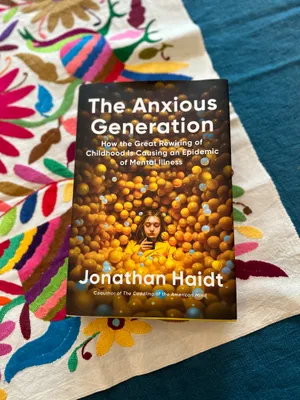Tech has rewired our kids' brains, a new book says. Can we undo the damage?
The screentime battles are already in full swing with my niece.
She turned 2 years old in January. “I want iPad,” she wails across the house during lunchtime. She refuses to eat, even though I can tell she’s “hangry.” She’s even more inconsolable when I tell her she can watch 10 minutes of Cocomelon only after she takes at least three bites of her lunch.
If it were up to me, I would throw “her” iPad away. I’m not kidding. I can’t stand to watch her – one of the most intelligent and empathic toddlers I’ve ever been around – get completely sucked in and tuned out on screens.
She taps and swipes and stares, totally hypnotized by its magnetic pull. Screens are already her go-to method of comfort, her favorite reward – even better than candy! – and all too often, the on-demand babysitter for her parents, who are overwhelmed and just trying to make it through the day.
There’s a lot to unpack here, and I have no idea how to help. To be fair, I whip out a phone as fast as anyone else when we’re all out to dinner together, and the crayons and puzzles stop working. We all just need a few bites of our food and five minutes of adult conversation, right?
What’s worse, I often feel powerless against the pull of my screens too. I have zero doubt that smartphones have rewired our brains in negative ways. Not because so many new studies suggest it, but because of how I feel and what I see happening in the world around me.
The always-on gadgets that were supposed to make my life easier, more fun, and more productive, now often disrupt my sleep, ruin any semblance of work-life balance, and wipe out my self-esteem. I get lost in rabbit holes nearly every time I pick up my smartphone, and I routinely feel incapacitated when it comes to doing anything about it.
As bad as I feel about my own smartphone and screens, I feel worse for our kids. I’ve witnessed them suffer the most – from our device addictions and their own.
Give them a smartphone or an all-access pass to social media too soon and risk alarming rates of “depression, anxiety, self-harm, and suicide.” But if you’re the one strict parent in the neighborhood who denies access, are you stunting their growth in an ever-evolving digital world and potentially socially ostracizing them too?
'The Anxious Generation:' Have smartphones ‘rewired’ childhood?
Everyone I know is talking about the new book, "The Anxious Generation: How the Great Rewiring of Childhood Is Causing an Epidemic of Mental Illness." In it, social psychologist, author, and New York University professor Jonathan Haidt stacks mountains of evidence indicating a correlation between the rise of smartphones and sharp declines in the well-being of our kids.
Haidt argues that the transition from a play-based to a phone-based youth has “rewired childhood.” He also says that it has “disrupted social and neurological development (and caused) social anxiety, sleep deprivation, attention fragmentation, and addiction.”
The problems ramped up around the year 2012, Haidt says. He cites hundreds of scientific studies and other high-quality data to paint smartphones, tablets, and social media as unstoppable forces, pushing Gen Z (people born after 1996) out of reality and into a digital world where rules aren’t always clear, people hide behind anonymous social media accounts, and rumors spread faster than wildfire.
Smartphones and social media aren’t the only culprits, though. Sure, they opened a can of worms by providing unrestricted access to carefully orchestrated algorithms trained to lure kids in and keep them coming back for more. But Haidt says it was those factors combined with the rise of “fearful and overprotective parenting (that started) in the 1980s,'' and continues to the present day, that created a perfect storm for a diminishing ability to raise healthy humans.
“We rewired childhood and created an epidemic of mental illness,” Haidt said in several recent interviews. “After more than a decade of stability or improvement, the mental health of adolescents plunged in the early 2010s. We have overprotected our children in the real world and underprotected them online.”
Critics argue that Haidt and his colleagues have all “mistaken correlation for causation,” among other complaints. But it looks like some of the sharpest critics haven’t actually read the book. The author is next-level transparent and shares the data and sources openly online.
Isn’t this just the latest 'parent panic?'
I’ll admit, it’s not an easy read as a parent. The most frustrating part, for me at least, is that I’ve known in my gut this was happening for over a decade. Most parents probably feel the same way, and despite doing our very best, we often fall back on the old, “Well, the train’s already left the station,” or “Before this, there was too much TV, and before that too much risqué rock music, and this is just the latest thing to freak out about” excuses.
But it’s pretty apparent that we’ve collectively relied too much on technology to pacify our kids. If life was a horror movie, this is where we’d realize “the call was coming from inside the house” all along.
Tech companies, of course, are all too happy to oblige. Most draw up extensive "Terms of Use" that prohibit kids of certain ages from using their services, but there’s virtually no enforcement of those guidelines. Ask anyone under the age of 13 how they managed to work around social media age restrictions, and they’ll say, “I lied about my age.” Um, duh.

Kids also love games and communicating with their friends online, and knowing when those habits cross over into problematic territory is proving to be more complicated than many parents imagined.
Social media and video games are among the worst offenders. “They hooked children during vulnerable developmental stages, while their brains were rapidly rewiring in response to incoming stimulation,” Haidt writes. “By designing a firehose of addictive content that entered through kids’ eyes and ears, and by displacing physical play and in-person socializing, these companies have rewired childhood and changed human development on an almost unimaginable scale.”
The damage, he says, is clear: An epidemic of pain and suffering among young people around the world that’s produced a generation of “failure to launch” boys and fragile, depressed girls.
Can we raise healthy humans alongside modern tech?
This is a question I’ve asked myself and hundreds of others in the past decade, both while covering consumer tech and raising a now 23-year-old daughter.
Here’s what I know for sure: extremes don’t work. “Zero tech” households are a lot like no-sugar families. Kids sneak, hide, and lie about the inevitable screentime they manage to finagle from friends, other families, and even school. They are often worse than their peers at self-regulation.
On the other end of the spectrum, giving a child their own smartphone before double-digits creates a sort of zombie apocalypse too. I’m thinking of one friend with a now 10-year-old daughter who spends nine or more hours a day on TikTok, Snapchat, and YouTube. She told me recently she would “die” without her phone.
Anecdotally, “extremely controlled” screen time seems to have the best outcomes, but that’s really hard and time-consuming for most parents to manage.
The problem is overwhelming. The peer pressure from other kids and even other parents is extreme.
Many teens and young adults I talk to wish there were clear requirements and boundaries similar to driving licenses and drinking ages. One recent study even noted that a majority of college students say they “wish TikTok and Instagram were never invented.” My daughter has told me the same thing.
“The biggest opponent we are facing is not that parents (or even teens) disagree with us; it is that so many feel hopeless,” Haidt’s lead researcher, Zach Rausch, wrote in an email. “Our goal is to show that there really is a lot we can do, especially if we act together.”
A smartphone replacement?:The Humane AI Pin is unlikely to soon replace the smartphone but it has some wow features
The book recommends four "new norms" to turn back the phone-based childhood:
◾ No smartphones before high school.
◾ No social media until 16.
◾ Schools should ban phones during the entire school day; just put them into a phone locker or Yondr pouch.
◾ Finally, we need to give our kids more independence, freedom, and responsibility to play or hang out with each other on their own in the real world, just as most of us did when we were their age.
Not all screen time is bad
Rausch is quick to point out that “not all screen time is bad.” He and Haidt recommend families watch an age-appropriate movie together or play a game in real-time with a friend or family member for a healthier dose of tech.
The problems, they say, come with sites like YouTube, “and other products designed to maximize the amount of time they spend on the platforms (e.g., TikTok). And it’s the asynchronous activities, such as posting and scrolling on social media, that sucks kids in and keeps them from real-world interactions that are crucial for their social development.”
Haidt recommends flip phones before high school. I’ve been preaching this for the past several years, too. (I use a $20 Straight Talk Wireless Nokia 2760 flip phone on nights and weekends to help with my smartphone addiction and have recently given a handful to my friends with middle-school-age kids.)
Haven’t we heard all of this before?
I’ve heard – and offered – most of these suggestions before and not seen any real change. What’s different now? Will we actually roll back the damage and create a healthier future for our children with tech? Can we get tech titans who won’t let their kids use the same devices and apps they created to put age limits and more real-life guardrails around their inventions? We have to try.

Haidt set a deadline and says society can “end the phone-based childhood by the end of 2025.” That’s a lofty goal, but he says we’re at a tipping point and he’s sure this can – and will – work.
“We find that we don't need to convince many people about the nature of the problem. Most people see it,” Haidt wrote on his Substack. “Our main opponents are despair and resignation. The four norms offer a way out of the trap.”
Haidt also compiled several “take action” resources for parents, schools, and everyone else who cares about this problem.
I plan to take my niece’s family a copy of "Anxious Generation." I’m not sure what else I can do for them except try my best to lead by example. That means I’ll put my own phone down when I’m with her (even if I might miss an adorable photo or 10). I also plan to take her outside and show her how to make mud pies. The messier we both get, the better.
Jennifer Jolly is an Emmy Award-winning consumer tech columnist and on-air correspondent.
The views and opinions expressed in this column are the author's and do not necessarily reflect those of USA TODAY. Contact her atJJ@Techish.com.
Disclaimer: The copyright of this article belongs to the original author. Reposting this article is solely for the purpose of information dissemination and does not constitute any investment advice. If there is any infringement, please contact us immediately. We will make corrections or deletions as necessary. Thank you.







